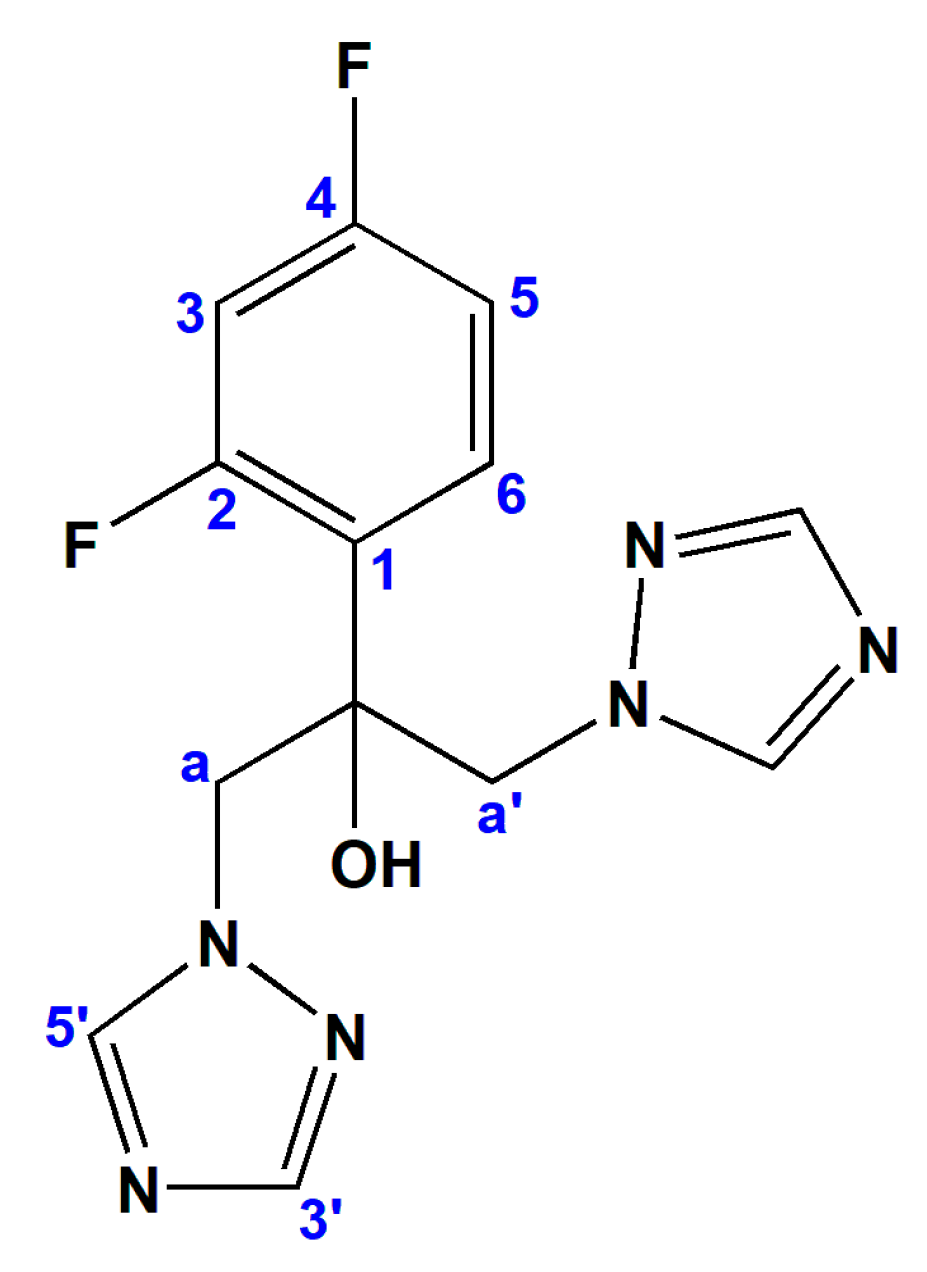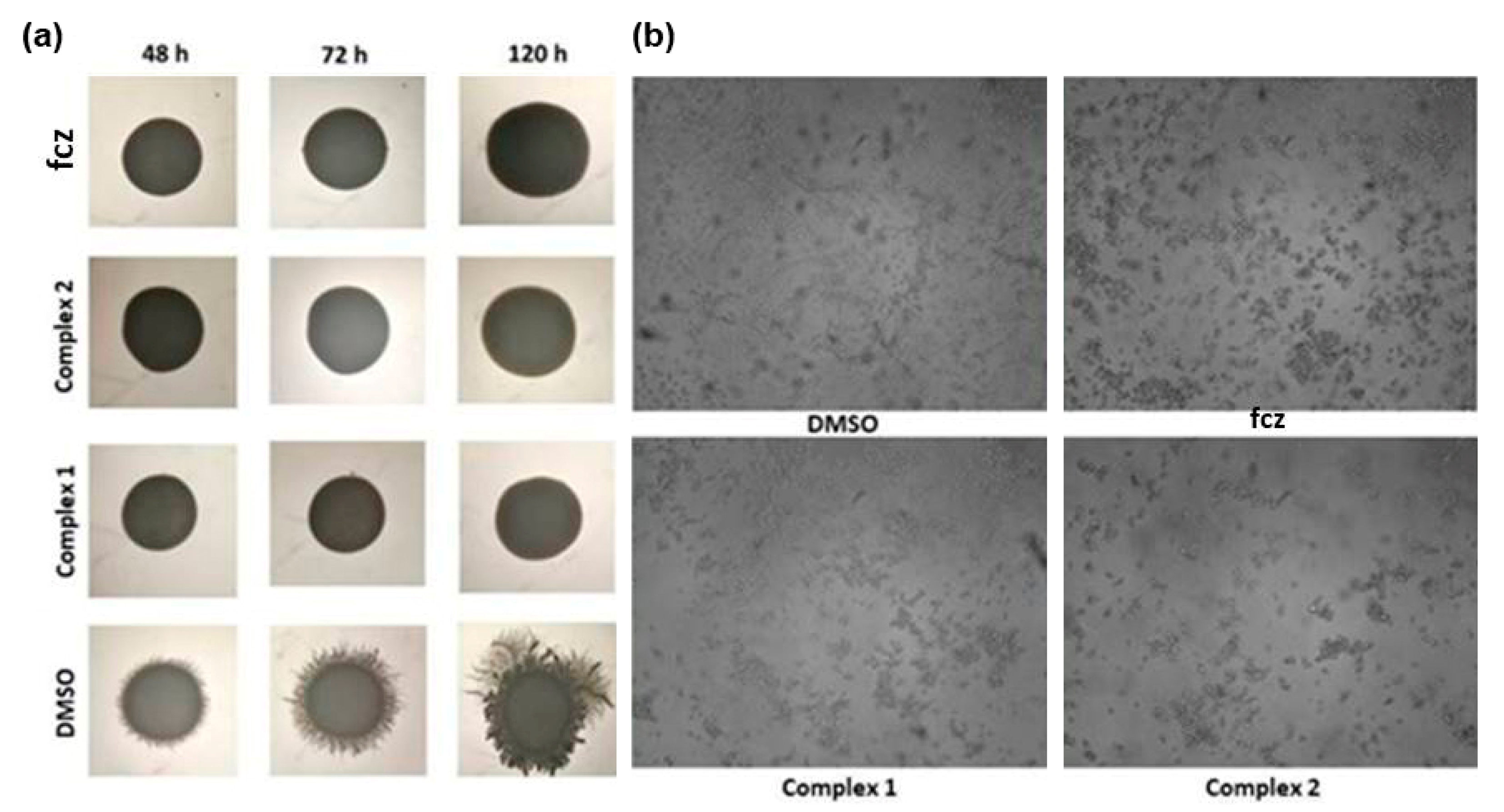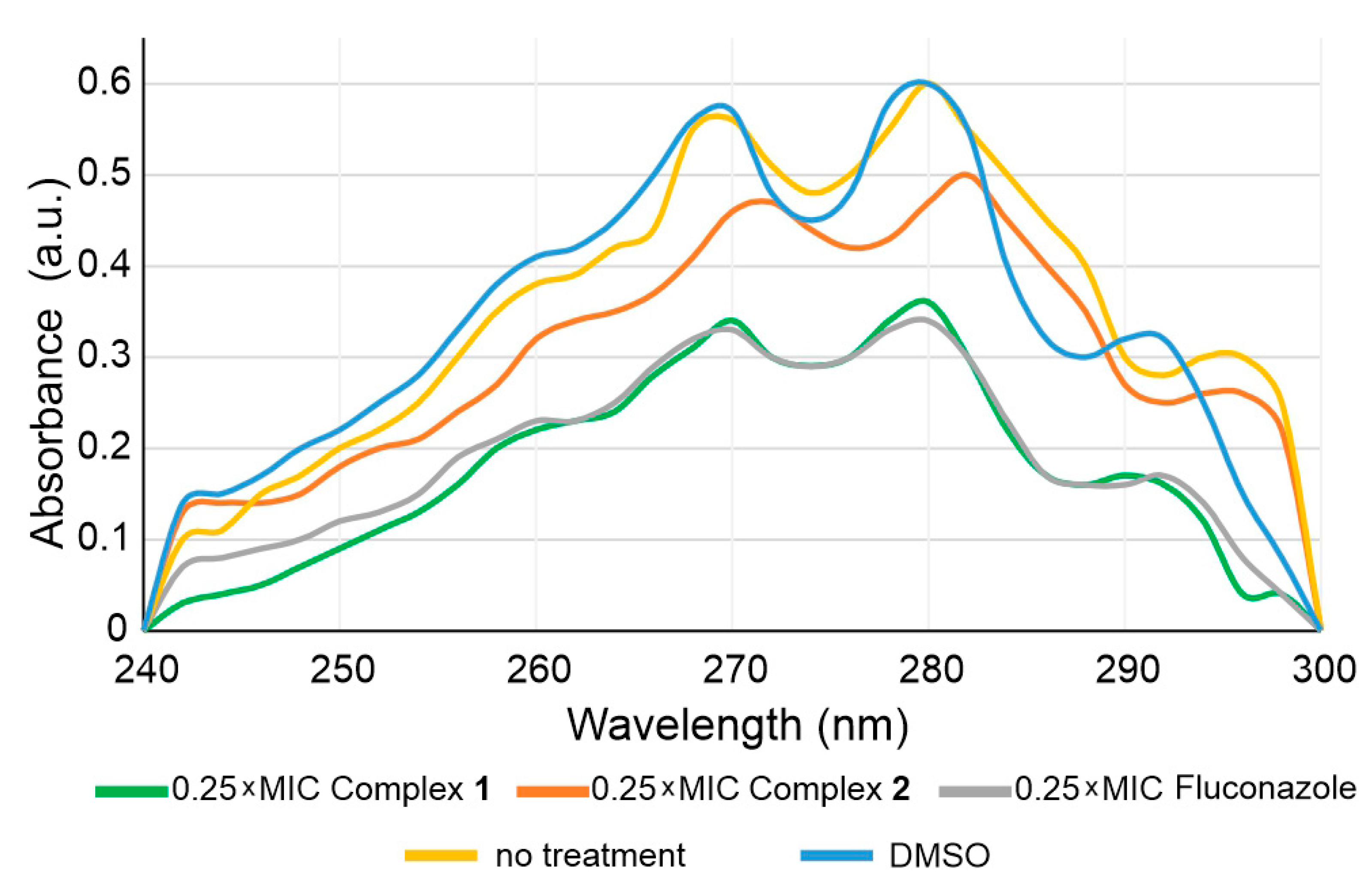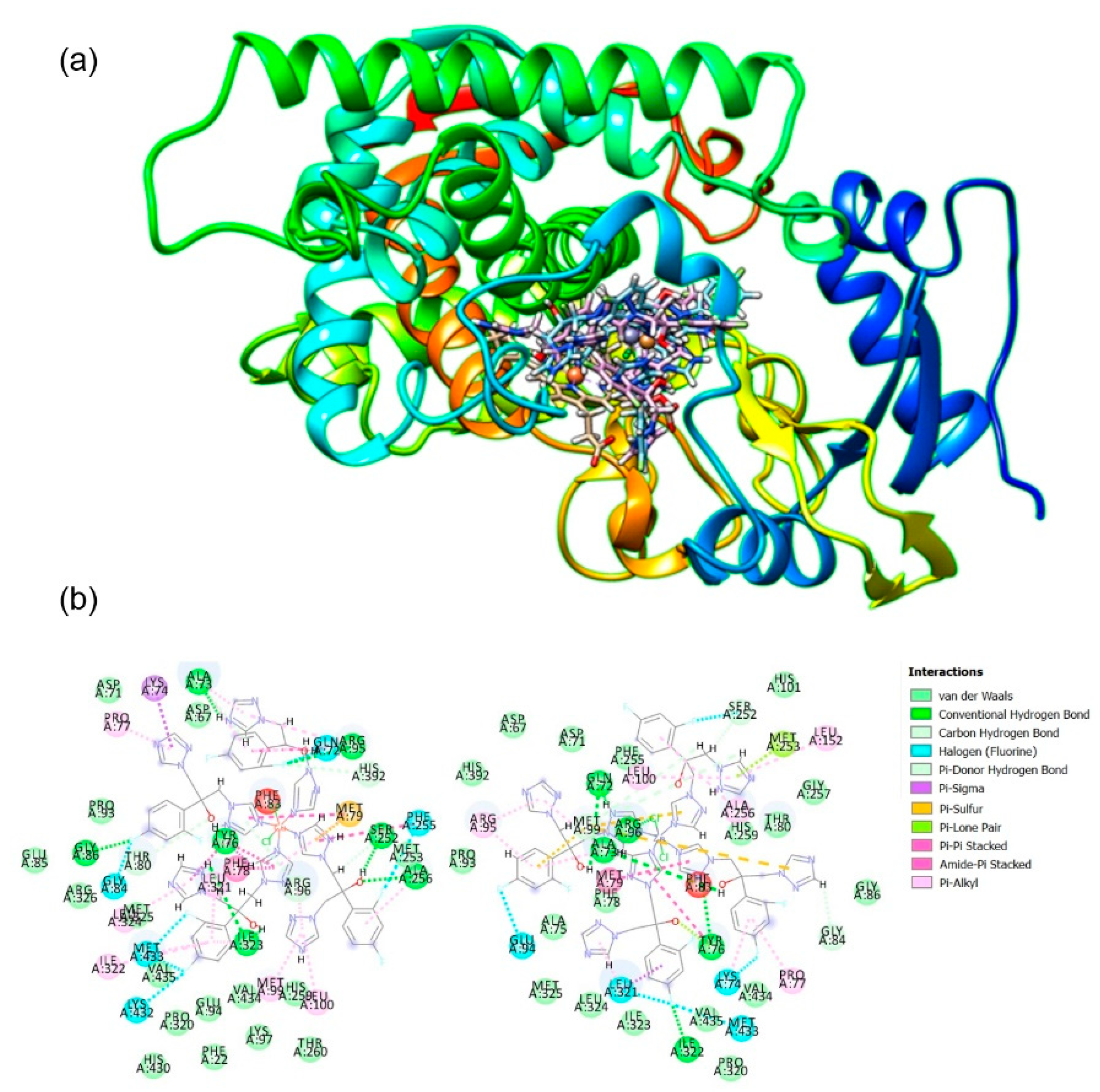Copper(II) and Zinc(II) Complexes with the Clinically Used Fluconazole: Comparison of Antifungal Activity and Therapeutic Potential
Abstract
1. Introduction
2. Results and Discussion
2.1. Synthesis and Structural Characterization of Complexes 1 and 2
2.1.1. Solid State Studies
2.1.2. Solution Behavior of Complexes 1 and 2
2.2. Comparative Biological Activity Evaluation of Fluconazole and Complexes 1 and 2
2.2.1. In Vitro Anti-Candida Properties
2.2.2. Ergosterol Biosynthesis in C. albicans Treated with Fluconazole and Complexes 1 and 2
2.2.3. Antibacterial and Anti-QS Effects
3. Materials and Methods
3.1. Materials and Measurements
3.2. Synthesis of Complexes 1 and 2
3.3. Crystallographic Data Collection and Refinement of the Structures
3.4. Anti-Candida Properties of Fluconazole and Complexes 1 and 2
3.4.1. Minimal Inhibitory Concentration (MIC) Values
3.4.2. Anti-Biofilm Activity Assessment
3.4.3. Yeast-to-Hyphae Transition
3.4.4. Cytotoxicity and Adherence Assay
3.4.5. Ergosterol Concentration
3.5. Molecular Docking
3.6. Antibacterial and Anti-quorum Sensing Properties of Fluconazole and Complexes 1 and 2
3.6.1. Chromobacterium violaceum CV026 Disc Assay
3.6.2. Serratia marcescens Disc Assay
3.6.3. Pyocyanin Assay
3.6.4. Evaluation of Quorum Sensing Inhibition Potential Using Biosensors
4. Conclusions
Supplementary Materials
Author Contributions
Funding
Institutional Review Board Statement
Informed Consent Statement
Data Availability Statement
Conflicts of Interest
References
- Kathiravan, M.K.; Salake, A.B.; Chothe, A.S.; Dudhe, P.B.; Watode, R.P.; Mukta, M.S.; Gadhwe, S. The biology and chemistry of antifungal agents: A review. Bioorg. Med. Chem. 2012, 20, 5678–5698. [Google Scholar] [CrossRef] [PubMed]
- Fisher, M.C.; Henk, D.A.; Briggs, C.J.; Brownstein, J.S.; Madoff, L.C.; McCraw, S.L.; Gurr, S.J. Emerging fungal treats to animal, plant and ecosystem health. Nature 2012, 484, 186–194. [Google Scholar] [CrossRef] [PubMed]
- Kupferschmidt, K. Attack of the clones. Science 2012, 337, 636–638. [Google Scholar] [CrossRef] [PubMed]
- Denning, D.W.; Bromley, M.J. How to bolster the antifungal pipeline. Science 2015, 347, 1414–1416. [Google Scholar] [CrossRef]
- Pfaller, M.A.; Diekema, D.J. Epidemiology of invasive candidiasis: A persistent public health problem. Clin. Microbiol. Rev. 2007, 20, 133–163. [Google Scholar] [CrossRef]
- Cao, X.; Sun, Z.; Cao, Y.; Wang, R.; Cai, T.; Chu, W.; Hu, W.; Yang, Y. Design, synthesis, and structure–activity relationship studies of novel fused heterocycles-linked triazoles with good activity and water solubility. J. Med. Chem. 2014, 57, 3687–3706. [Google Scholar] [CrossRef]
- Maertens, J.A. History of the development of azole derivatives. Clin. Microbiol. Infect. 2004, 10, 1–10. [Google Scholar] [CrossRef]
- Graninger, W.; Diab-Elschahawi, M.; Presterl, E. Antifungal agents. In Clinically Relevant Mycoses; Presterl, E., Ed.; Springer: Cham, Switzerland, 2019; pp. 31–42. [Google Scholar]
- Kelly, S.L.; Kelly, D.E. Microbial cytochromes P450: Biodiversity and biotechnology. Where do cytochromes P450 come from, what do they do and what can they do for us? Phil. Trans. R. Soc. B 2013, 368, 20120476. [Google Scholar] [CrossRef]
- Correa, J.C.R.; Salgado, H.R.N. Review of fluconazole properties and analytical methods for its determination. Crit. Rev. Anal. Chem. 2011, 41, 124–132. [Google Scholar] [CrossRef]
- Alessio, E. Bioinorganic Medicinal Chemistry; Wiley-VCH Verlag & Co. KGaA: Weinheim, Germany, 2011. [Google Scholar]
- Zoroddu, M.A.; Aaseth, J.; Crisponi, G.; Medici, S.; Peana, M.; Nurchi, V.M. The essential metals for humans: A brief overview. J. Inorg. Biochem. 2019, 195, 120–129. [Google Scholar] [CrossRef]
- Jiang, Z.; You, Q.; Zhang, X. Medicinal chemistry of metal chelating fragments in metalloenzyme active sites: A perspective. Eur. J. Med. Chem. 2019, 165, 172–197. [Google Scholar] [CrossRef]
- Frei, A. Metal complexes, an untapped source of antibiotic potential? Antibiotics 2020, 9, 90. [Google Scholar] [CrossRef] [PubMed]
- Morrison, C.N.; Prosser, K.E.; Stokes, R.W.; Cordes, A.; Metzler-Nolte, N.; Cohen, S.M. Expanding medicinal chemistry into 3D space: Metallofragments as 3D scaffolds for fragment-based drug discovery. Chem. Sci. 2020, 11, 1216–1225. [Google Scholar] [CrossRef]
- Schatzschneider, U. Antimicrobial activity of organometal compounds. In Advances in Bioorganometallic Chemistry; Hirao, T., Moriuchi, T., Eds.; Elsevier: Amsterdam, The Netherlands, 2019; pp. 173–192. [Google Scholar]
- Sharma, R.K.; Katiyar, D. Recent advances in the development of coumarin derivatives as antifungal agents. In Recent Trends in Human and Animal Mycology; Singh, K., Srivastava, N., Eds.; Springer Nature: Singapore, 2019; pp. 235–263. [Google Scholar]
- Kaczmarek, M.T.; Jastrząb, R.; Hołderna-Kędzia, E.; Radecka-Paryzek, W. Self-assembled synthesis, characterization and antimicrobial activity of zinc(II) salicylaldimine complexes. Inorg. Chim. Acta 2009, 362, 3127–3133. [Google Scholar] [CrossRef]
- Zaltariov, M.-F.; Cazacu, M.; Avadanei, M.; Shova, S.; Balan, M.; Vornicu, N.; Vlad, A.; Dobrov, A.; Varganici, C.-D. Synthesis, characterization and antimicrobial activity of new Cu(II) and Zn(II) complexes with Schiff bases derived from trimethylsilyl-propyl-p-aminobenzoate. Polyhedron 2015, 100, 121–131. [Google Scholar] [CrossRef]
- Radovanović, L.; Rogan, J.; Poleti, D.; Milutinović, M.; Rodić, M.V. Polymeric zinc complexes with 2,2′-dipyridylamine and different benzenepolycarboxylato ligands: Synthesis, structure, characterization and antimicrobial activity. Polyhedron 2016, 112, 18–26. [Google Scholar] [CrossRef]
- Yamgar, R.S.; Nivid, Y.; Nalawade, S.; Mandewale, M.; Atram, R.G.; Sawant, S.S. Novel zinc(II) complexes of heterocyclic ligands as antimicrobial agents: Synthesis, characterisation, and antimicrobial studies. Bioinorg. Chem. Appl. 2014, 2014, 276598. [Google Scholar] [CrossRef]
- Katugampala, S.; Perera, I.C.; Nanayakkara, C.; Perera, T. Synthesis, characterization, and antimicrobial activity of novel sulfonated copper-triazine complexes. Bioinorg. Chem. Appl. 2018, 2018, 2530851. [Google Scholar] [CrossRef]
- Castillo, K.F.; Bello-Vieda, N.J.; Nuñez-Dallos, N.G.; Pastrana, H.F.; Celis, A.M.; Restrepo, S.; Hurtado, J.J.; Ávila, A.G. Metal complex derivatives of azole: A study on their synthesis, characterization, and antibacterial and antifungal activities. J. Braz. Chem. Soc. 2016, 27, 2334–2347. [Google Scholar] [CrossRef]
- Andrejević, T.P.; Warżajtis, B.; Glišić, B.Đ.; Vojnovic, S.; Mojicevic, M.; Stevanović, N.L.; Nikodinovic-Runic, J.; Rychlewska, U.; Djuran, M.I. Zinc(II) complexes with aromatic nitrogen-containing heterocycles as antifungal agents: Synergistic activity with clinically used drug nystatin. J. Inorg. Biochem. 2020, 208, 111089. [Google Scholar] [CrossRef]
- de Azevedo França, J.A.; Granado, R.; de Macedo Silva, S.T.; dos Santos-Silva, G.; Scapin, S.; Borba-Santos, L.P.; Rozental, S.; de Souza, W.; Martins-Duarte, É.S.; Barrias, E.; et al. Synthesis and biological activity of novel zinc-itraconazole complexes in protozoan parasites and Sporothrix spp. Antimicrob. Agents Chemother. 2020, 64, e01980-19. [Google Scholar] [CrossRef] [PubMed]
- Han, H.; Zhang, S.; Hou, H.; Fan, Y.; Zhu, Y. Fe(Cu)-containing coordination polymers: Syntheses, crystal structures, and applications as benzyl alcohol oxidation catalysts. Eur. J. Inorg. Chem. 2006, 8, 1594–1600. [Google Scholar] [CrossRef]
- Pan, G.-H.; Tang, J.-N.; Yin, X.-H.; Li, P.-F.; Huang, Z.-J. Synthesis, crystal structure, and properties of cobalt, zinc, and manganese coordination polymers based on fluconazole. J. Coord. Chem. 2014, 67, 1962–1979. [Google Scholar] [CrossRef]
- Gong, Y.; Hu, C.W.; Xia, Z.N. Synthesis and characterization of metal(II)–fluconazole complexes: Chain-like structure and photoluminescence. J. Mol. Struct. 2007, 837, 48–57. [Google Scholar] [CrossRef]
- Gong, Y.; Liu, J.; Hu, C.; Gao, W. Solvent-induced supramolecular isomers: Two dimensional coordination polymers constructed by Cu(II) and fluconazole. Inorg. Chem. Commun. 2007, 10, 575–579. [Google Scholar] [CrossRef]
- Zhang, L.; Ling, Y.; Li, D.-J.; Li, J.; Du, M. Synthesis, crystal structures and properties of novel zinc(II) and cadmium(II) polymeric and cyclic bimetallic complexes with fluconazole and dicarboxylate co-ligands. Inorg. Chim. Acta 2010, 363, 1031–1038. [Google Scholar] [CrossRef]
- Han, H.; Song, Y.; Hou, H.; Fan, Y.; Zhu, Y. A series of metal–organic polymers assembled from MCl2 (M = Zn, Cd, Co, Cu): Structures, third-order nonlinear optical and fluorescent properties. Dalton Trans. 2006, 1972–1980. [Google Scholar] [CrossRef]
- Ferjani, H.; Bechaieb, R.; El-Fattah, W.A.; Fettouhi, M. Broad-band luminescence involving fluconazole antifungal drug in a lead-free bismuth iodide perovskite: Combined experimental and computational insights. Spectrochim. Acta Part A 2020, 237, 118354. [Google Scholar] [CrossRef]
- Trabelsi, S.; Issaoui, N.; Brandán, S.A.; Bardak, F.; Roisnel, T.; Atac, A.; Marouani, H. Synthesis and physic-chemical properties of a novel chromate compound with potential biological applications, bis(2-phenylethylammonium) chromate(VI). J. Mol. Struct. 2019, 1185, 168–182. [Google Scholar] [CrossRef]
- Nagaj, J.; Starosta, R.; Szczepanik, W.; Barys, M.; Młynarz, P.; Jeżowska-Bojczuk, M. The Cu(II)-fluconazole complex revisited. Part I: Structural characteristics of the system. J. Inorg. Biochem. 2012, 106, 23–31. [Google Scholar] [CrossRef]
- Pan, G.-H.; Tang, J.-N.; Xu, S.-H.; Huang, Z.-J.; Mo, B.-F. Poly[[μ-chlorido-μ-[2-(2,4-difluorophenyl)-1,3-bis(1,2,4-triazol-1-yl)propan-2-ol-κ2N4:N4′]-zinc] chloride dihydrate]. Acta Cryst. E 2013, 69, m573. [Google Scholar] [CrossRef] [PubMed]
- Cyr, T.D.; Dawson, B.A.; Neville, G.A.; Shurvell, H.F. Spectral characterization of fluconazole. J. Pharm. Biomed. Anal. 1996, 14, 247–255. [Google Scholar] [CrossRef]
- Geary, W.J. The use of conductivity measurements in organic solvents for the characterisation of coordination compounds. Coord. Chem. Rev. 1971, 7, 81–122. [Google Scholar] [CrossRef]
- Ali, I.; Wani, W.A.; Saleem, K. Empirical formulae to molecular structures of metal complexes by molar conductance. Synth. React. Inorg. M. 2013, 43, 1162–1170. [Google Scholar] [CrossRef]
- Hathaway, B.J. Comprehensive Coordination Chemistry; Wilkinson, G., Gillard, R.D., McCleverty, J.A., Eds.; Pergamon: Oxford, UK, 1987; Volume 5, pp. 533–774. [Google Scholar]
- Drašković, N.S.; Radanović, D.D.; Rychlewska, U.; Warżajtis, B.; Stanojević, I.M.; Djuran, M.I. Synthesis and spectral characterization of nickel(II) and copper(II) complexes with the hexadentate (±)-1,3-pentanediamine-N,N,N’,N’-tetraacetate ligand and its pentadentate derivative: Stereospecific formation and crystal structure of [Mg(H2O)6][Ni(1,3-pndta)]·4H2O. Polyhedron 2012, 43, 185–193. [Google Scholar]
- Liss, R.H.; Letourneau, R.J. Fungispecificity of fluconazole against Candida albicans. Mycopathologia 1989, 108, 173–178. [Google Scholar] [CrossRef]
- Besold, A.N.; Gilston, B.A.; Radin, J.N.; Ramsoomair, C.; Culbertson, E.M.; Li, C.X.; Cormack, B.P.; Chazin, W.J.; Kehl-Fie, T.E.; Culotta, V.C. Role of calprotectin in withholding zinc and copper from Candida albicans. Infect. Immun. 2018, 86, e00779-17. [Google Scholar] [CrossRef]
- Hosseini, S.S.; Ghaemi, E.; Noroozi, A.; Niknejad, F. Zinc oxide nanoparticles inhibition of initial adhesion and ALS1 and ALS3 gene expression in Candida albicans strains from urinary tract infections. Mycopathologia 2019, 184, 261–271. [Google Scholar] [CrossRef]
- Guo, S.; Yang, W.; Zhao, M.; Tian, R.; Zhang, B.; Qi, Y. In Vitro anticandidal activity and mechanism of a polyoxovanadate functionalized by Zn-fluconazole complexes. Molecules 2018, 23, 1122. [Google Scholar] [CrossRef]
- Gitarić, J.; Stanojević, I.M.; Rodić, M.V.; Drašković, N.S.; Stevanović, M.; Vojnović, S.; Djuran, M.I.; Glišić, B.Đ. Structural characterization and biological evaluation of polynuclear Mn(II) and Cd(II) complexes with 2,2-dimethyl-1,3-propanediamine-N,N,N’,N’-tetraacetate. The influence of ligand structure and counter cation on the complex nuclearity. Polyhedron 2020, 188, 114688. [Google Scholar] [CrossRef]
- Savić, N.D.; Vojnovic, S.; Glišić, B.Đ.; Crochet, A.; Pavic, A.; Janjić, G.V.; Pekmezović, M.; Opsenica, I.M.; Fromm, K.M.; Nikodinovic-Runic, J.; et al. Mononuclear silver(I) complexes with 1,7-phenanthroline as potent inhibitors of Candida growth. Eur. J. Med. Chem. 2018, 156, 760–773. [Google Scholar] [CrossRef]
- Fonseca, D.; Leal-Pinto, S.M.; Roa-Cordero, M.V.; Vargas, J.D.; Moreno-Moreno, E.M.; Macías, M.A.; Suescun, L.; Muñoz-Castro, Á.; Hurtado, J.J. Inhibition of C. albicans dimorphic switch by cobalt(II) complexes with ligands derived from pyrazoles and dinitrobenzoate: Synthesis, characterization and biological activity. Int. J. Mol. Sci. 2019, 20, 3237. [Google Scholar] [CrossRef]
- Taff, H.T.; Mitchell, K.F.; Edward, J.A.; Andes, D.R. Mechanisms of Candida biofilm drug resistance. Future Microbiol. 2013, 8, 1325–1337. [Google Scholar] [CrossRef] [PubMed]
- Madhavan, P.; Jamal, F.; Pei, C.P.; Othman, F.; Karunanidhi, A.; Ng, K.P. Comparative study of the effects of fluconazole and voriconazole on Candida glabrata, Candida parapsilosis and Candida rugosa biofilms. Mycopathologia 2018, 183, 499–511. [Google Scholar] [CrossRef] [PubMed]
- da Silva Dantas, F.G.; de Almeida-Apolonio, A.A.; de Araújo, R.P.; Favarin, L.R.V.; de Castilho, P.F.; de Oliveira Galvão, F.; Svidzinski, T.I.E.; Casagrande, G.A.; de Oliveira, K.M.P. A promising copper(II) complex as antifungal and antibiofilm drug against yeast infection. Molecules 2018, 23, 1856. [Google Scholar] [CrossRef] [PubMed]
- Ballou, E.R.; Wilson, D. The roles of zinc and copper sensing in fungal pathogenesis. Curr. Opin. Microbiol. 2016, 32, 128–134. [Google Scholar] [CrossRef]
- Nobile, C.J.; Nett, J.E.; Hernday, A.D.; Homann, O.R.; Deneault, J.-S.; Nantel, A.; Andes, D.R.; Johnson, A.D.; Mitchell, A.P. Biofilm matrix regulation by Candida albicans Zap1. PLoS Biol. 2009, 7, e1000133. [Google Scholar] [CrossRef]
- Malavia, D.; Lehtovirta-Morley, L.E.; Alamir, O.; Weiß, E.; Gow, N.A.R.; Hube, B.; Wilson, D. Zinc limitation induces a hyper-adherent goliath phenotype in Candida albicans. Front Microbiol. 2017, 8, 2238. [Google Scholar] [CrossRef]
- Turecka, K.; Chylewska, A.; Kawiak, A.; Waleron, K.F. Antifungal activity and mechanism of action of the Co(III) coordination complexes with diamine chelate ligands against reference and clinical strains of Candida spp. Front. Microbiol. 2018, 9, 1594. [Google Scholar] [CrossRef]
- Douglas, L.M.; Konopka, J.B. Fungal membrane organization: The eisosome concept. Annu. Rev. Microbiol. 2014, 68, 377–393. [Google Scholar] [CrossRef]
- Pasko, M.T.; Piscitelli, S.C.; Van Slooten, A.D. Fluconazole: A new triazole antifungal agent. DICP 1990, 24, 860–867. [Google Scholar] [CrossRef] [PubMed]
- Zhang, H.-Z.; Damu, G.L.V.; Cai, G.-X.; Zhou, C.-H. Design, synthesis and antimicrobial evaluation of novel benzimidazole type of fluconazole analogues and their synergistic effects with chloromycin, norfloxacin and fluconazole. Eur. J. Med. Chem. 2013, 64, 329–344. [Google Scholar] [CrossRef] [PubMed]
- Chowdhary, A.; Kathuria, S.; Xu, J.; Meis, J.F. Emergence of azole-resistant Aspergillus fumigatus strains due to agricultural azole use creates an increasing threat to human health. PLoS Pathog. 2013, 9, e1003633. [Google Scholar] [CrossRef]
- Kljun, J.; Scott, A.J.; Lanisnik Rizner, T.; Keiser, J.; Turel, I. Synthesis and biological evaluation of organoruthenium complexes with azole antifungal agents. First crystal structure of a tioconazole metal complex. Organometallics 2014, 33, 1594–1601. [Google Scholar] [CrossRef]
- Gajdács, M.; Spengler, G. The role of drug repurposing in the development of novel antimicrobial drugs: Non-antibiotic pharmacological agents as quorum sensing-inhibitors. Antibiotics 2019, 8, 270. [Google Scholar] [CrossRef] [PubMed]
- Glišić, B.Đ.; Aleksic, I.; Comba, P.; Wadepohl, H.; Ilic-Tomic, T.; Nikodinovic-Runic, J.; Djuran, M.I. Copper (II) complexes with aromatic nitrogen-containing heterocycles as effective inhibitors of quorum sensing activity in Pseudomonas aeruginosa. RSC Adv. 2016, 6, 86695–86709. [Google Scholar] [CrossRef]
- Dubern, J.-F.; Diggle, S.P. Quorum sensing by 2-alkyl-4-quinolones in Pseudomonas aeruginosa and other bacterial species. Mol. BioSyst. 2008, 4, 882–888. [Google Scholar] [CrossRef]
- CrysAlis PRO; Oxford Diffraction Ltd.: Yarnton, Oxfordshire, UK, 2011.
- Dolomanov, O.V.; Bourhis, L.J.; Gildea, R.J.; Howard, J.A.K.; Puschmann, H. OLEX2: A complete structure solution, refinement and analysis program. J. Appl. Crystallogr. 2009, 42, 339–341. [Google Scholar] [CrossRef]
- Sheldrick, G.M. SHELXL2018/3; University of Göttingen: Göttingen, Germany, 2018. [Google Scholar]
- Macrae, C.F.; Edgington, P.R.; McCabe, P.; Pidcock, E.; Shields, G.P.; Taylor, R.; Towler, M.; van de Streek, J. Mercury: Visualization and analysis of crystal structures. J. Appl. Crystallogr. 2006, 39, 453–457. [Google Scholar] [CrossRef]
- Andrejević, T.P.; Milivojevic, D.; Glišić, B.Đ.; Kljun, J.; Stevanović, N.L.; Vojnovic, S.; Medic, S.; Nikodinovic-Runic, J.; Turel, I.; Djuran, M.I. Silver (I) complexes with different pyridine-4,5-dicarboxylate ligands as efficient agents for the control of cow mastitis associated pathogens. Dalton Trans. 2020, 49, 6084–6096. [Google Scholar] [CrossRef]
- Ajdačić, V.; Senerovic, L.; Vranić, M.; Pekmezovic, M.; Arsic-Arsnijevic, V.; Veselinovic, A.; Veselinovic, J.; Šolaja, B.A.; Nikodinovic-Runic, J.; Opsenica, I.M. Synthesis and evaluation of thiophene-based guanylhydrazones (iminoguanidines) efficient against panel of voriconazole-resistant fungal isolates. Bioorg. Med. Chem. 2016, 24, 1277–1291. [Google Scholar] [CrossRef] [PubMed]
- Jakab, Á.; Mogavero, S.; Förster, T.M.; Pekmezovic, M.; Jablonowski, N.; Dombradi, V.; Pócsi, I.; Hube, B. Effects of the glucocorticoid betamethasone on the interaction of Candida albicans with human epithelial cells. Microbiology 2016, 162, 2116–2125. [Google Scholar] [CrossRef] [PubMed]
- Pierce, C.G.; Uppuluri, P.; Tristan, A.R.; Wormley Jr, F.L.; Mowat, E.; Ramage, G.; Lopez-Ribot, J.L. A simple and reproducible 96-well plate-based method for the formation of fungal biofilms and its application to antifungal susceptibility testing. Nat. Protoc. 2008, 3, 1494–1500. [Google Scholar] [CrossRef] [PubMed]
- Mohamed, B.S.R.; Subramanian, M.; Shunmugiah, K.P. Inhibition of Candida albicans virulence factors by novel levofloxacin derivatives. Appl. Microbiol. Biot. 2014, 98, 6775–6785. [Google Scholar] [CrossRef]
- Arthington-Skaggs, B.A.; Jradi, H.; Desai, T.; Morrison, C.J. Quantitation of ergosterol content: Novel method for determination of fluconazole susceptibility of Candida albicans. J. Clin. Microbiol. 1999, 37, 3332–3337. [Google Scholar] [CrossRef]
- Senerovic, L.; Zivkovic, M.D.; Veselinovic, A.; Pavic, A.; Djuran, M.I.; Rajkovic, S.; Nikodinovic-Runic, J. Synthesis and evaluation of series of diazine-bridged dinuclear platinum (II) complexes through in vitro toxicity and molecular modeling: Correlation between structure and activity of Pt (II) complexes. J. Med. Chem. 2015, 58, 1442–1451. [Google Scholar] [CrossRef]
- Amin, E.A.; Truhlar, D.G. Zn coordination chemistry: Development of benchmark suites for geometries, dipole moments, and bond dissociation energies and their use to test and validate density functionals and molecular orbital theory. J. Chem. Theory Comput. 2008, 4, 75–85. [Google Scholar] [CrossRef]
- Frison, G.; Ohanessian, G. A comparative study of semiempirical, ab initio, and DFT methods in evaluating metal–ligand bond strength, proton affinity, and interactions between first and second shell ligands in Zn-biomimetic complexes. J. Com. Chem. 2008, 29, 416–433. [Google Scholar] [CrossRef]
- Stewart, J.J.P. Optimization of parameters for semiempirical methods V: Modification of NDDO approximations and application to 70 elements. J. Mol. Model. 2007, 13, 1173–1213. [Google Scholar] [CrossRef]
- Glišić, B.Ð.; Nikodinovic-Runic, J.; Ilic-Tomic, T.; Wadepohl, H.; Veselinović, A.; Opsenica, I.M.; Djuran, M.I. Synthesis, cytotoxic activity and DNA-binding properties of copper (II) complexes with terpyridine. Polyhedron 2018, 139, 313–322. [Google Scholar] [CrossRef]
- CLSI, Clinical and Laboratory Standards Institute. Methods for Dilution Antimicrobial Susceptibility Tests for Bacteria that Grow Aerobically. In Approved Standard, 10th ed.; CLSI: Wayne, PA, USA, 2015. [Google Scholar]
- Milivojevic, D.; Šumonja, N.; Medić, S.; Pavic, A.; Moric, I.; Vasiljevic, B.; Senerovic, L.; Nikodinovic-Runic, J. Biofilm-forming ability and infection potential of Pseudomonas aeruginosa strains isolated from animals and humans. Pathog. Dis. 2018, 76, fty041. [Google Scholar] [CrossRef] [PubMed]
- Merritt, J.H.; Kadouri, D.E.; O’Toole, G.A. Growing and analyzing static biofilms. Curr. Protoc. Microbiol. 2005. [Google Scholar] [CrossRef]
- McClean, K.H.; Winson, M.K.; Fish, L.; Taylor, A.; Chhabra, S.R.; Camara, M.; Daykin, M.; Lamb, J.H.; Swift, S.; Bycroft, B.W.; et al. Quorum sensing and Chromobacterium violaceum: Exploitation of violacein production and inhibition for the detection of N-acylhomoserine lactones. Microbiology 1997, 143, 3703–3711. [Google Scholar] [CrossRef]
- Aleksić, I.; Šegan, S.; Andrić, F.; Zlatović, M.; Moric, I.; Opsenica, D.M.; Senerovic, L. Long-chain 4-aminoquinolines as quorum sensing inhibitors in Serratia marcescens and Pseudomonas aeruginosa. ACS Chem. Biol. 2017, 12, 1425–1434. [Google Scholar] [CrossRef] [PubMed]
- O’Loughlin, C.T.; Miller, L.C.; Siryaporn, A.; Drescher, K.; Semmelhack, M.F.; Bassler, B.L. A quorum-sensing inhibitor blocks Pseudomonas aeruginosa virulence and biofilm formation. Proc. Natl. Acad. Sci. USA 2013, 110, 17981–17986. [Google Scholar] [CrossRef] [PubMed]
- Massai, F.; Imperi, F.; Quattrucci, S.; Zennaro, E.; Visca, P.; Leoni, L. A multitask biosensor for micro-volumetric detection of N-3-oxo-dodecanoyl-homoserine lactone quorum sensing signal. Biosens. Bioelectron. 2011, 26, 3444–3449. [Google Scholar] [CrossRef] [PubMed]
- Duan, K.; Surette, M.G. Environmental regulation of Pseudomonas aeruginosa PAO1 Las and Rhl quorum-sensing systems. J. Bacteriol. 2007, 189, 4827–4836. [Google Scholar] [CrossRef]
- Fletcher, M.P.; Diggle, S.P.; Crusz, S.A.; Chhabra, S.R.; Camara, M.; Williams, P. A dual biosensor for 2-alkyl-4 quinolone quorum-sensing signal molecules. Environ. Microbiol. 2007, 9, 2683–2693. [Google Scholar] [CrossRef]
- Aleksic, I.; Jeremic, J.; Milivojevic, D.; Ilic-Tomic, T.; Šegan, S.; Zlatović, M.; Opsenica, D.M.; Senerovic, L. N-Benzyl derivatives of long-chained 4-amino-7-chloro-quionolines as inhibitors of pyocyanin production in Pseudomonas aeruginosa. ACS Chem. Biol. 2019, 14, 2800–2809. [Google Scholar] [CrossRef]








| Tested Organisms | 1 | 2 | Fluconazole | |||
|---|---|---|---|---|---|---|
| µg/mL | µM | µg/mL | µM | µg/mL | µM | |
| C. albicans ATCC 10231 | 50 | 59.8 | 3.12 | 3.71 | 0.88 | 2.87 |
| C. parapsilosis ATCC 22019 | 1.75 | 2.09 | 0.88 | 1.05 | 1.75 | 5.71 |
| C. krusei ATCC 6258 | 50 | 59.8 | 3.12 | 3.71 | 12.50 | 40.81 |
| C. albicans 1c a | 2 | 2.39 | 2 | 2.38 | 2 | 6.53 |
| C. albicans 1f | 2 | 2.39 | 2 | 2.38 | 2 | 6.53 |
| C. albicans 11 | 2 | 2.39 | 2 | 2.38 | 2 | 6.53 |
| C. albicans 13 | 2 | 2.39 | 2 | 2.38 | 2 | 6.53 |
| MRC-5 | 72 ± 2 | 86 ± 2 | 65 ± 4 | 77 ± 5 | 300 ± 8 | 980 ± 26 |
| Compounds | Pyocyanin Inhibition, % | Biofilm Inhibition, % | ||
|---|---|---|---|---|
| P. aeruginosa PA14 | P. aeruginosa DM50 | P. aeruginosa S20 | ||
| 1 | 0 | 0 | 0 | |
| 2 | 26 ± 8 | 25 ± 1 | 13 ± 3 | 25.2 ± 9 |
| fcz | 0 | 12 ± 10 | 0 | |
Publisher’s Note: MDPI stays neutral with regard to jurisdictional claims in published maps and institutional affiliations. |
© 2020 by the authors. Licensee MDPI, Basel, Switzerland. This article is an open access article distributed under the terms and conditions of the Creative Commons Attribution (CC BY) license (http://creativecommons.org/licenses/by/4.0/).
Share and Cite
Stevanović, N.L.; Aleksic, I.; Kljun, J.; Skaro Bogojevic, S.; Veselinovic, A.; Nikodinovic-Runic, J.; Turel, I.; Djuran, M.I.; Glišić, B.Đ. Copper(II) and Zinc(II) Complexes with the Clinically Used Fluconazole: Comparison of Antifungal Activity and Therapeutic Potential. Pharmaceuticals 2021, 14, 24. https://doi.org/10.3390/ph14010024
Stevanović NL, Aleksic I, Kljun J, Skaro Bogojevic S, Veselinovic A, Nikodinovic-Runic J, Turel I, Djuran MI, Glišić BĐ. Copper(II) and Zinc(II) Complexes with the Clinically Used Fluconazole: Comparison of Antifungal Activity and Therapeutic Potential. Pharmaceuticals. 2021; 14(1):24. https://doi.org/10.3390/ph14010024
Chicago/Turabian StyleStevanović, Nevena Lj., Ivana Aleksic, Jakob Kljun, Sanja Skaro Bogojevic, Aleksandar Veselinovic, Jasmina Nikodinovic-Runic, Iztok Turel, Miloš I. Djuran, and Biljana Đ. Glišić. 2021. "Copper(II) and Zinc(II) Complexes with the Clinically Used Fluconazole: Comparison of Antifungal Activity and Therapeutic Potential" Pharmaceuticals 14, no. 1: 24. https://doi.org/10.3390/ph14010024
APA StyleStevanović, N. L., Aleksic, I., Kljun, J., Skaro Bogojevic, S., Veselinovic, A., Nikodinovic-Runic, J., Turel, I., Djuran, M. I., & Glišić, B. Đ. (2021). Copper(II) and Zinc(II) Complexes with the Clinically Used Fluconazole: Comparison of Antifungal Activity and Therapeutic Potential. Pharmaceuticals, 14(1), 24. https://doi.org/10.3390/ph14010024









